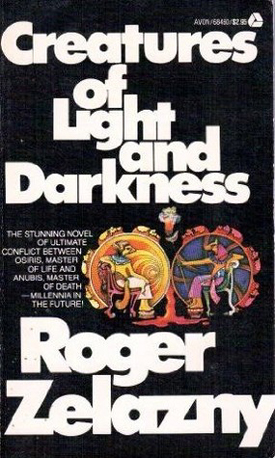 Roger Zelazny’s Creatures of Light and Darkness is one of the more bizarre science fiction novels in the canon. I should point out that before the advent of the New Wave writers in the 1960s, science fiction reserved its adventurousness for the ideas portrayed; formal considerations — the character of the text — were very much in line with the naturalism established as the reigning paradigm for literature in the nineteenth century. Indeed, ironically enough, writers of science fiction and fantasy had demonstrated less interest in narrative experimentation than so-called “mainstream” writers such as Joyce, Woolf, and Faulkner.
Roger Zelazny’s Creatures of Light and Darkness is one of the more bizarre science fiction novels in the canon. I should point out that before the advent of the New Wave writers in the 1960s, science fiction reserved its adventurousness for the ideas portrayed; formal considerations — the character of the text — were very much in line with the naturalism established as the reigning paradigm for literature in the nineteenth century. Indeed, ironically enough, writers of science fiction and fantasy had demonstrated less interest in narrative experimentation than so-called “mainstream” writers such as Joyce, Woolf, and Faulkner.
Enter Zelazny. Among his other virtues, Roger Zelazny was as willing to experiment with narrative structures as he was with thematic content. This wasn’t a constant thing — most of his writings fit into a standard naturalistic narrative framework quite easily — but one catches glimpses in, for example, the “traveling” passages in Nine Princes in Amber. Creatures of Light and Darkness, published in book form in 1970, shows Zelazny at his most inventive, formally and thematically. (A stray and possibly relevant thought: the dedication reads “To Chip Delany, Just Because.” Samuel R. Delany, another of the American New Wave’s luminaries, has a well-known fondness for experimental literature. I can’t point to any cause and effect relationship, or delineate any concrete influences, but given the wild mix of narrative forms here, one does wonder.)
Creatures is also the second of Zelazny’s novels to cast an ancient pantheon — in this case, that of Egypt (with cameos by Cerberus, the Minotaur, and the Norns, among others) — into an interplanetary setting. Osiris and Anubis have usurped the rule of the Middle Worlds (and isn’t it interesting to think how many mythologies posit humanity as inhabiting a “middle” realm?) as lords of the Houses of Life and Death, respectively. Ranged against them are Thoth, the Prince Who Was A Thousand, whom they both seek to destroy; Typhon, who is the complete absence of everything; and Set, whose name has been taken from him. The story is told through a combination of straight narrative, dramatic monologues, and verse, and, as a coda, a brief one-act play.
I must mention the style of the writing itself, the feel of the techniques Zelazny has used to tell this story. It’s not the verse portions, which as poetry are pedestrian at best. Call them a sort of “verse prose” as opposed to “prose poetry,” which is a different thing altogether. Zelazny’s verse is purely a matter of form rather than substance. The narratives, though, have a lunatic, explosive, sometimes hallucinatory cast to them in which much of the meaning lies between and around the words, which is where true poetry is to be found, after all. One finds oneself rebounding from image to image, sometimes stark, sometimes almost cloying, and even Zelazny’s characteristic stilted dialogue fits right in.
I can’t in good faith make the claim that Creatures was in and of itself tremendously influential. Science fiction and fantasy writers still, after all, use everyday, naturalistic narrative to tell their stories, and mythological archetypes have always been part of the storyteller’s arsenal. It is, I think, a successful novel, and because of that establishes a new boundary for the possible. It’s also a totally absorbing book.
(Avon Books, 1970)
